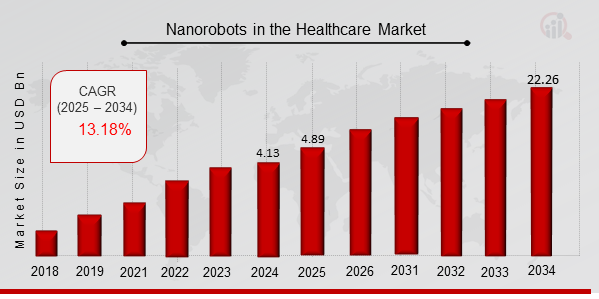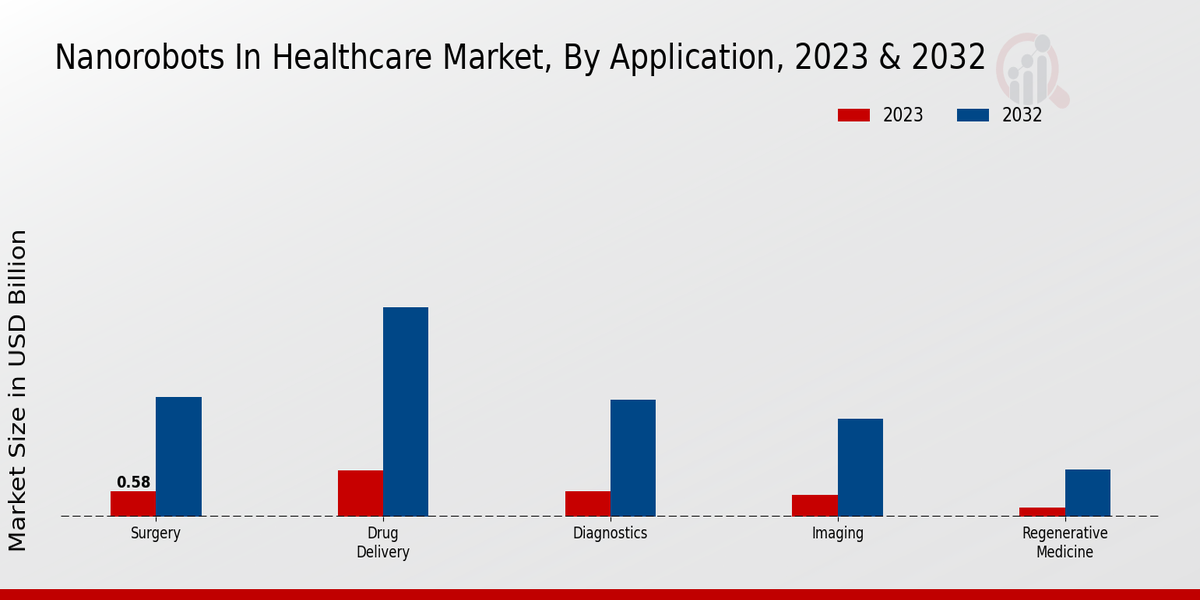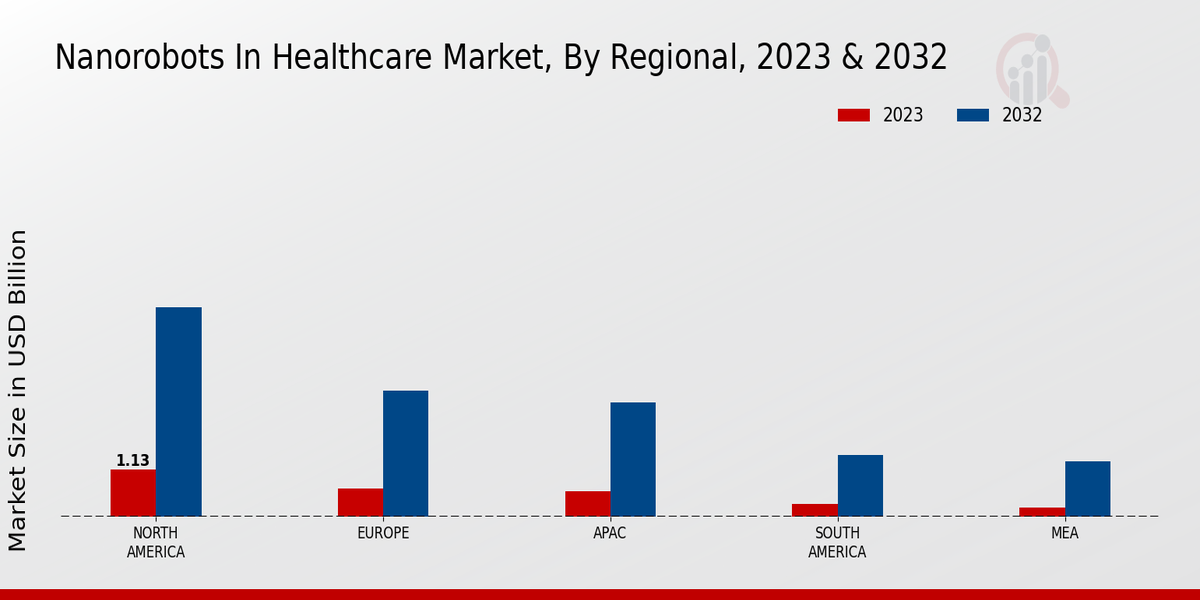Nanorobots in Healthcare Market Overview
As per MRFR analysis, the Nanorobots in the Healthcare Market Size was estimated at 4.13 (USD Billion) in 2024. The Nanorobots in the Healthcare Market Industry is expected to grow from 4.89 (USD Billion) in 2025 to 22.26 (USD Billion) till 2034, at a CAGR (growth rate) is expected to be around 18.35% during the forecast period (2025 - 2034).
Key Nanorobots in Healthcare Market Trends Highlighted
The Nanorobots in Healthcare Market is experiencing significant growth driven by multiple factors. Advancements in nanotechnology are enhancing the development of innovative medical devices and therapies that can target diseases at the cellular level. This precision in drug delivery and diagnostics is addressing the increasing need for effective treatments and minimizing side effects. Additionally, an aging population and the rising burden of chronic diseases are fueling the demand for advanced healthcare solutions, prompting increased investment in research and development in this sector. There are numerous opportunities to be explored within this market.As awareness about the potential of nanorobots in healthcare continues to grow, various stakeholders, including pharmaceutical and biotechnology companies, are looking into collaborations that can accelerate the application of nanotechnology in medicine.
The integration of artificial intelligence with nanorobots presents a chance to enhance their functionality and precision, making them an attractive option for future healthcare advancements. Further research into regulatory frameworks will also open avenues for improved approval processes, allowing for faster market entry of innovative solutions. In recent times, sustainability has emerged as a key trend influencing the development of nanorobots.Researchers are focusing on creating materials and processes that are environmentally friendly while still maintaining efficacy in medical applications. The emerging trend towards personalized medicine is also gaining traction, with nanorobots being seen as a potential solution to tailor treatments to individual patient needs. These trends signify a shift towards more patient-centric approaches, which can enhance treatment outcomes and overall satisfaction in healthcare delivery. The confluence of these drivers, opportunities, and trends sets the stage for a transformative era in healthcare through the integration of nanorobots.

Source: Primary Research, Secondary Research, MRFR Database and Analyst Review
Nanorobots in Healthcare Market Drivers
Rapid Advancements in Nanotechnology
The Nanorobots in Healthcare Market Industry is experiencing significant growth due to rapid advancements in nanotechnology. This field has seen breakthroughs that allow for the creation of highly sophisticated nanorobots capable of performing complex tasks at a microscopic level. These advancements enable the development of innovative healthcare solutions, such as targeted drug delivery systems, precision diagnostics, and even minimally invasive surgical procedures.As technology continues to evolve, nanorobots are expected to play a pivotal role in enhancing the accuracy and effectiveness of medical treatments. The growing demand for personalized medicine, where therapies are tailored to individual patients based on their specific needs, is further driving the need for advanced nanorobots capable of delivering treatments at a cellular level. Consequently, this creates numerous opportunities in the Nanorobots in the Healthcare Market, as healthcare providers look for new ways to incorporate nanotechnology into patient care.Additionally, ongoing research and collaboration among academic institutions, biotechnology firms, and healthcare organizations are promoting innovations in nanorobotics, leading to new product development and expanding market potential.
Increasing Prevalence of Chronic Diseases
One of the major drivers for the Nanorobots in the Healthcare Market Industry is the rising prevalence of chronic diseases such as cancer, diabetes, and cardiovascular disorders. These conditions require effective and targeted treatment options, which nanorobots can provide. By utilizing nanotechnology, healthcare professionals can precisely target affected cells, minimizing damage to surrounding healthy tissues and improving patient outcomes. As the population continues to age and lifestyles contribute to increased health issues, the demand for innovative treatment methods will continue to rise, driving market growth.
Growth in Investment for Nanomedicine Research
Investment in the field of nanomedicine is another critical driver aiding the Nanorobots in the Healthcare Market Industry. Governments, private sectors, and venture capitalists are increasingly funding research and development initiatives in nanotechnology, promoting the advancement of nanorobots. This financial support enables the exploration of new applications and technologies, accelerating product development and commercialization processes ultimately boosting market growth.
Nanorobots in Healthcare Market Segment Insights
Nanorobots in Healthcare Market Application Insights
The Nanorobots in Healthcare Market generates substantial revenue, with 2023 figures highlighting a total market value of 2.94 USD Billion. The market is structured intricately, focusing specifically on various applications such as Surgery, Drug Delivery, Diagnostics, Imaging, and Regenerative Medicine. Each of these applications exhibits unique growth traits. Notably, the Surgery application, valued at 0.585 USD Billion in 2023 and projected to expand to 2.71 USD Billion by 2032, holds a prominent position due to the increasing demand for precision and minimally invasive surgical techniques, bolstered by advancements in nanotechnology, which improve surgical outcomes and recovery times significantly.The Drug Delivery application stands out with a valuation of 1.046 USD Billion in 2023, expected to rise to 4.745 USD Billion by 2032, showcasing a significant growth factor given the rising need for targeted therapy. This sub-segment is paramount as it enhances the effectiveness of medications, reduces side effects, and ensures that drugs reach the intended site of action more efficiently.
The Diagnostics application, bringing in 0.588 USD Billion in 2023 and anticipated to escalate to 2.65 USD Billion by 2032, is crucial for early disease detection and preventive healthcare.Innovations in diagnostic methods are vital since timely diagnosis directly affects treatment efficacy and patient outcomes. Imaging represents a growing segment, starting at 0.493 USD Billion in 2023 and predicted to reach 2.23 USD Billion by 2032, which is significant for non-invasive procedures, allowing healthcare professionals to visualize internal structures and changes without surgical interventions. Lastly, the Regenerative Medicine application, with a valuation of 0.22 USD Billion in 2023 and a projected growth to 1.065 USD Billion by 2032, plays a crucial role in healing and restoring damaged tissues or organs, utilizing nanorobotic technology to enhance the regenerative processes.
The Nanorobots in Healthcare Market segmentation reveals a landscape driven by innovation, with each application significantly impacting the industry, supported by trends such as personalized medicine, an increasing prevalence of chronic diseases, and a push towards advanced healthcare solutions. The market growth is propelled by technological advancements and an escalating demand for improved healthcare services, although challenges such as regulatory compliance and high development costs remain pivotal. The confluence of these factors underscores the importance of understanding Nanorobots in Healthcare Market data and statistics, which ultimately guide stakeholders in making informed investment decisions within this dynamic industry.

Source: Primary Research, Secondary Research, MRFR Database and Analyst Review
Nanorobots in Healthcare Market Type Insights
The Nanorobots in Healthcare Market, valued at 2.94 billion USD in 2023, showcases a diverse range of market types, including Biological Nanorobots, Mechanical Nanorobots, and Hybrid Nanorobots. Biological Nanorobots leverage molecular biology for precise drug delivery and cellular functions, thus holding a significant share of the market due to their potential in targeted therapies. Mechanical Nanorobots, designed for precise surgical operations, play a crucial role in minimally invasive procedures, contributing to their importance in the current healthcare landscape.Meanwhile, Hybrid Nanorobots, which combine elements of both biological and mechanical designs, are gaining traction for their versatility and adaptability in various applications. The increasing focus on precision medicine and advancements in nanotechnology act as key growth drivers for the market. However, challenges such as regulatory hurdles and technical limitations may impede market growth. The Nanorobots in Healthcare Market segmentation reflects a dynamic industry poised for expansion, with each type contributing uniquely to advancements in healthcare solutions.Overall, the market is expected to witness significant transformation and opportunity as it continues to evolve over the coming years.
Nanorobots in Healthcare Market End-Use Insights
The Nanorobots in Healthcare Market is experiencing notable expansion, with a valuation of 2.94 billion USD in 2023. This market comprises various end-use categories, including hospitals, research laboratories, pharmaceutical companies, and academic institutions. Hospitals are significant players, utilizing nanorobots for targeted drug delivery and minimally invasive surgeries, which enhances treatment effectiveness and patient safety. Research laboratories contribute to innovations and advancements in nanotechnology applications, thus driving the market forward.Meanwhile, pharmaceutical companies leverage nanorobots for improved drug formulation and personalized medicine, establishing their crucial role in market growth. Academic institutions focus on education and research that fosters new developments in nanorobots, contributing to the industry's ongoing evolution. Overall, the Nanorobots in Healthcare Market segmentation reflects a diverse landscape, with each segment playing a critical role in addressing healthcare challenges and enhancing patient outcomes, thereby creating a significant impact on the overall market growth.As the market evolves, it presents numerous opportunities for technological advancements and new applications, reinforcing the industry's potential for transformation in healthcare.
Nanorobots in Healthcare Market Material Insights
The Nanorobots in Healthcare Market is experiencing significant growth, with a projected value of 2.94 USD Billion in 2023. This market is largely segmented by Material, encompassing various types such as Metallic Nanorobots, Polymeric Nanorobots, and Carbon-Based Nanorobots. Among these, Metallic Nanorobots hold a prominent position due to their robust mechanical properties, making them effective for targeted drug delivery and surgical applications. Meanwhile, Polymeric Nanorobots are becoming increasingly essential due to their biocompatibility and versatility, allowing for a range of applications, including diagnostics and therapeutics.Carbon-based nanorobots are also gaining traction, attributed to their unique properties that enhance functionality and performance in nanoscale applications. The dynamics within these segments are driven by increasing demand for advanced healthcare solutions, innovation in nanotechnology, and the growing prevalence of chronic diseases that require precision therapies. However, challenges persist, including regulatory hurdles and the need for extensive research to ensure safety and efficacy. Overall, the Nanorobots in Healthcare Market is poised for substantial growth, supported by the diverse applications of its material segments.
Nanorobots in Healthcare Market Regional Insights
The Nanorobots in Healthcare Market shows a promising landscape across regional segments, with a valuation of 2.94 USD Billion in 2023, and set to grow significantly by 2032. North America holds the majority, valued at 1.131 USD Billion in 2023, reflecting its advanced healthcare infrastructure and strong research initiatives, leading to a significant presence of nanotechnology applications. Europe follows closely with a valuation of 0.678 USD Billion, driven by increasing investments in healthcare innovations and collaborative research. The APAC region, valued at 0.603 USD Billion, demonstrates substantial growth potential due to its expanding healthcare sector and rising technological adoption.
Meanwhile, South America contributes a value of 0.302 USD Billion, marking its emerging significance in the market landscape despite being less dominant. The MEA region, with a valuation of 0.226 USD Billion, is gradually establishing itself in nanotechnology applications in healthcare, signifying room for growth. Overall, the segmentation illustrates varied dynamics and opportunities within the Nanorobots in Healthcare Market, with diverse growth drivers and emerging challenges.

Source: Primary Research, Secondary Research, MRFR Database and Analyst Review
Nanorobots in Healthcare Market Key Players and Competitive Insights:
The Nanorobots in Healthcare Market has shown remarkable growth due to the increasing demand for minimally invasive procedures and the rise of advanced robotics technology in health services. As healthcare providers aim to enhance patient outcomes through precision medicine and tailored treatments, the integration of nanotechnology in medical devices has emerged as a focal area. This dynamic market entails an intricate competitive landscape where various companies are innovating solutions that leverage nanorobotics to address critical healthcare challenges.
From targeted drug delivery systems to enhanced diagnostic capabilities, the competitive environment is defined by rapid advancements and strategic collaborations, enabling players to establish strong market positions. Organizations involved in this sector strive to capitalize on trends such as personalized medicine, robotic surgeries, and real-time health monitoring, illustrating the pivotal role of nanorobots in modern healthcare solutions.
Abbot Laboratories has positioned itself as a formidable player in the Nanorobots in the Healthcare Market, showcasing its strengths through a robust pipeline of innovative products and technologies. The company emphasizes research and development, investing significantly in advancing nanorobotic applications that improve diagnostic and therapeutic outcomes. With a solid reputation for quality and reliability, Abbot Laboratories harnesses cutting-edge technology to develop nanorobots capable of precise drug delivery and real-time monitoring systems catering to various medical specialties. Their strong partnerships with research institutions and universities bolster their capacity to bring revolutionary nanotechnology solutions to market in a timely manner.
Additionally, their extensive presence allows them to effectively leverage distribution networks and capitalize on diverse opportunities across different regions, thus reinforcing Abbot Laboratories' competitive edge in the nanorobotics sector.Medtronic is another key competitor within the Nanorobots in Healthcare Market, known for its innovative approach to integrating robotics and nanotechnology in medical applications. The company focuses on creating advanced solutions that enhance surgical precision and patient safety, thus addressing the pressing needs of modern medicine. Medtronic's strengths lie in its expansive product portfolio and commitment to ongoing innovation, allowing it to introduce cutting-edge nanorobotic systems that facilitate minimally invasive procedures.
Through strategic partnerships and collaborations, Medtronic continually enhances its research capabilities and product offerings, ensuring that it remains at the forefront of technological advancements. Moreover, their extensive reach and established brand reputation contribute to strong customer loyalty, enabling Medtronic to effectively compete in this dynamic market while addressing evolving healthcare demands.
Key Companies in the Nanorobots in Healthcare Market Include
- Abbot Laboratories
- Medtronic
- HoffmannLa Roche
- CureMetrix
- NanoString Technologies
- Stryker
- Mitsubishi Electric
- IBM
- Philips
- Thermo Fisher Scientific
- Johnson and Johnson
- Becton Dickinson
- Siemens
- Nanosys
- Zebra Medical Vision
Nanorobots in Healthcare Market Industry Developments
Recent developments in the Nanorobots in Healthcare Market have been significant, particularly with advancements in nanoscale technologies used for drug delivery and diagnostic applications. Companies like Abbot Laboratories and Medtronic are actively investing in research to enhance their nanorobotic capabilities. For instance, F. Hoffmann-La Roche is innovating in molecular diagnostics through nanotechnology, while CureMetrix focuses on improving mammography through AI-driven nanorobots. Meanwhile, Siemens and Thermo Fisher Scientific are exploring collaborations to integrate nanorobots into their existing healthcare solutions. Notably, Johnson & Johnson and Becton Dickinson are pursuing strategic partnerships aimed at expanding their nanotechnology platforms, while NanoString Technologies and Zebra Medical Vision are making strides in data-driven healthcare through their respective technologies. Mergers and acquisitions are also a focal point, with ongoing discussions in the industry that could see companies like Stryker and Mitsubishi Electric seeking to strengthen their positions through strategic buyouts. The growing interest in nanorobots is reflected in the increased market valuation of these companies, reshaping competitive dynamics and accelerating innovation within the healthcare sector as these firms vie for leadership in this emerging field.
Nanorobots in Healthcare Market Segmentation Insights
Nanorobots in Healthcare Market Application Outlook
Nanorobots in Healthcare Market Type Outlook
- Biological Nanorobots
- Mechanical Nanorobots
- Hybrid Nanorobots
Nanorobots in Healthcare Market End-Use Outlook
- Hospitals
- Research Laboratories
- Pharmaceutical Companies
- Academic Institutions
Nanorobots in Healthcare Market Material Outlook
- Metallic Nanorobots
- Polymeric Nanorobots
- Carbon-Based Nanorobots
Nanorobots in Healthcare Market Regional Outlook
-
North America
-
Europe
-
South America
-
Asia-Pacific
-
Middle East and Africa
| Report Attribute/Metric |
Details |
|
Market Size 2024
|
4.13 (USD Billion)
|
|
Market Size 2025
|
4.89 (USD Billion)
|
|
Market Size 2034
|
22.26 (USD Billion)
|
|
Compound Annual Growth Rate (CAGR)
|
18.35 % (2025 - 2034)
|
|
Report Coverage
|
Revenue Forecast, Competitive Landscape, Growth Factors, and Trends
|
|
Base Year
|
2024
|
|
Market Forecast Period
|
2025 - 2034
|
|
Historical Data
|
2020 - 2024
|
| Market Forecast Units |
USD Billion |
| Key Companies Profiled |
Abbot Laboratories, Medtronic, F. HoffmannLa Roche, CureMetrix, NanoString Technologies, Stryker, Mitsubishi Electric, IBM, Philips, Thermo Fisher Scientific, Johnson and Johnson, Becton Dickinson, Siemens, Nanosys, Zebra Medical Vision |
| Segments Covered |
Application, Type, End Use, Material, Regional |
| Key Market Opportunities |
Targeted drug delivery systems, Minimally invasive surgical procedures, Personalized medicine advancements, Diagnostics and imaging enhancement, and Regenerative medicine applications. |
| Key Market Dynamics |
Technological advancements, Rising prevalence of diseases, Increasing healthcare expenditure, Growing demand for precision medicine, Supportive government initiatives |
| Countries Covered |
North America, Europe, APAC, South America, MEA |
Frequently Asked Questions (FAQ) :
The projected market size of the Nanorobots in Healthcare Market by 2034 is expected to reach 22.26 USD Billion.
The expected CAGR for the Nanorobots in Healthcare Market from 2025 to 2034 is 18.35%.
The Drug Delivery application is leading the Nanorobots in Healthcare Market with a value of 1.046 USD Billion in 2023.
The North American market for Nanorobots in Healthcare is expected to be valued at 4.956 USD Billion by 2032.
The expected value for the Diagnostics application of Nanorobots in Healthcare by 2032 is 2.65 USD Billion.
Major players in the Nanorobots in Healthcare Market include companies such as Medtronic, Abbott Laboratories, and Johnson Johnson.
The anticipated market value for the Regenerative Medicine application in 2032 is 1.065 USD Billion.
The APAC region is expected to show significant growth in the Nanorobots in Healthcare Market, with a projected value of 2.697 USD Billion by 2032.
The market value for the Imaging application of Nanorobots in Healthcare in 2023 was 0.493 USD Billion.
The expected market value for South America in the Nanorobots in the Healthcare sector by 2032 is projected to be 1.458 USD Billion.


















